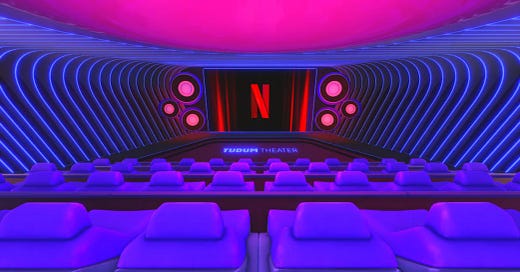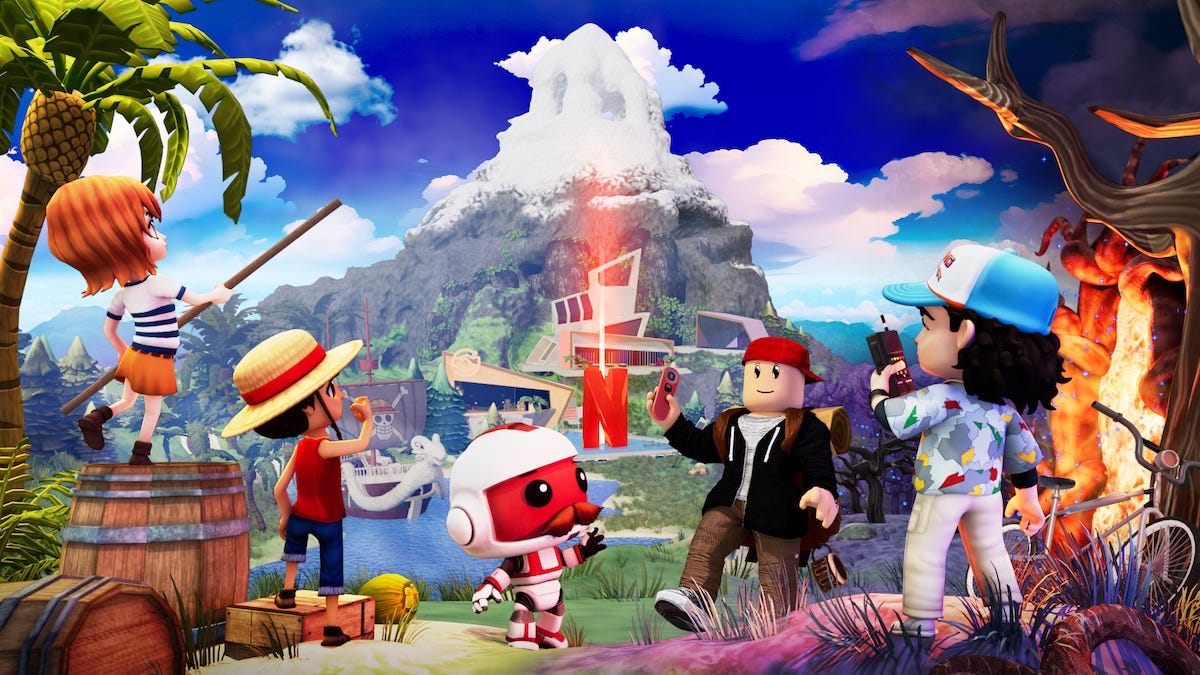Netflix’s Nextworld could be better
Transmedia is primed for its next wave, with web3 as the accelerant
The past few years have been a kind of heyday for transmedia, as wildly successful game-to-movie/TV ports have shown that you can commercially and artistically bridge the digital interactive and passive entertainment divide. (TV/film-to-games flows have been a bit more challenging, and few games have matched the zeitgeist of GoldenEye, though Sony’s Spider-Man games have sold tens of millions of copies.) This is good news, since these poster children shake the old stigma of really bad adaptations that turned users—and a lot of IP holders—away from the entire premise.
And these fuller adaptations are on top of the branded integrations that many movie and TV IP do inside of games like Fortnite, Roblox, and others on a regular basis. But there’s one thing that remains largely true for these transmedia efforts to date: they’re marketing stunts, not core business strategies. By this I mean that TV/film games are typically run by marketing or licensing departments. Branded games can be important—and even massive—money makers for companies, but their primary focus is to get in front of eyeballs with something that exists “over there with that audience,” not “ here with our audience.” This sounds like a small distinction, but it’s the difference between a game that has only a unilateral connection with its original IP (i.e. movie becomes game), and a bidirectional, interactive relationship (e.g. players’ in-game actions could impact the show narrative for the next season; buying a movie ticket makes X happen in-game; etc.)
The old way
The disconnect between game and movie/TV content is becoming more evident as new, original film IP gives way to recurring streaming shows and franchise movies and games, meaning that there are more staggered and ongoing ways that shows, movies, and games can intertwine with each other. For example, even with how massive a hit Titanic was back in the day, there wasn’t much of a benefit in having a Titanic game for marketing or any other purposes. It wasn’t like there was going to be Titanic 2: Colder and Wetter driving a benefit for users to stay engaged with the story between movies. It’s a different case, however, with The Last of Us. HBO knew in making the first season that it had the game’s sequel to build another season off of if the first went well (which it did). Naughty Dog, on the flip side, is certainly not going to ignore the temptation for a third hit game and third hit TV season, giving HBO all the more reason to think more narratives are coming for them to build new seasons around. Now we’ve got a real cycle going.
Speaking of HBO, I saw the tension between game strategy and core business strategy play out in real time about a decade ago. HBO came to SuperData wanting guidance on building some kind of mobile game for “Game of Thrones.” I asked them:
“What do you want this game to do:
Keep existing users engaged in the IP in between seasons?
Onboard new users as HBO subscribers?
Earn you lots of revenue?”
They said, “Yes.”
I gently suggested that that’s not really how games work. If you want a hit game, you’re likely spending lots of upfront money on user acquisition—something HBO wouldn’t do, and its third party developer definitely wouldn’t do. If you want eyeballs and engagement, you’re likely not putting a lot of paywalls in the game, meaning you’re risking revenue. And getting players to convert to HBO subscribers simply because they’re enjoying some tangentially-related casual mobile gameplay isn’t something that gaming is traditionally set up to do (more on this later). Historically, these games have struggled to serve both purposes of marketing fodder and accelerating core business strategies. This is starting to change, and can be improved on even more quickly.
The intermediate step
Recently, Netflix announced that it’s created Nextworld, a “digital theme park” built in Roblox where people can engage with some of the major Netflix IP like “Stranger Things.” In general, these kinds of branded Roblox activations aren’t new, with companies from Gucci to Walmart having launched Roblox activations. Normally, those are one-and-done campaigns, more akin to the “marketing fodder” branded game than anything more meaningful.
Netflix is clearly signaling that this isn’t a single-use or limited-time destination, and instead is part of their heavy investment into gaming. Players can engage with multiple Netflix IP at once, play minigames, earn in-game currency that they can use to unlock collectibles and decorate their own private “pods.” There are even in-game previews for upcoming shows, like a “Jurassic World” series, where players can watch the trailer on a screen in an in-game theater. It’s cute. It’s also a pretty sizable shift from past branded game activations, since this world changes to reflect new things happening in the Netflix realm.
But for Netflix, this is still an indirect tie to their core business, which is subscriptions. I can play in Nextworld all I want, but there’s no direct link between what I do in-game and my proclivity to purchase or keep a subscription. This means we’re still in the land of marketing: Netflix is obviously making a (likely data-backed) assumption that time spent in Nextworld = subscription purchase or retention. This fact that this experience exists inside of Roblox, however, stretches the basis for the assumption of Nextworld play turning into a Netflix sub. Roblox’s audience skews younger. Netflix knows it needs to woo younger users who can be future subscribers—or at least demand that their parents keep the multi-device (and more expensive) family account—but these Roblox players themselves are unlikely to hold the purse strings for the Netflix account. And beyond that, there’s literally no direct linkage between an in-game purchase and a Netflix subscription. There isn’t a way to walk up to a Roblox NPC and buy a Netflix subscription from them.
All in all, Nextworld is a step in the right direction for how film/TV IP should think about ongoing gaming engagement as part of what benefits their core business objectives, but it’s also a big effort that leaves a lot up to chance.
The future potential
One of the reasons that it’s hard for games to more directly lead into activity on other platforms is because of the nature of traditional game and platform infrastructure. A closed ecosystem game like Roblox and a closed platform like Netflix don’t talk to each other. They don’t share servers, they don’t share user accounts, they don’t share much underlying technology, which means that what happens in Roblox stays in Roblox, what occurs on Netflix is stuck on Netflix. Yes, Netflix is probably able to get some basic data from Roblox, maybe even some semblance of attribution, but it’s not enough to say with certainty “Roblox increased our retention 6% this year.”
This is what the blockchain excels at: it connects worlds through a common technology backbone and universally readable database. I’ve spent plenty of time talking about how an NFT could be used by a company like Disney, so I won’t revisit all of that (and NFTs aren’t the only way for movies to get involved with the future). There are a number of paths where Netflix’s leverage of web3 would make sure it’s harnessing the power of its gaming efforts in a way that measurably benefits the subscription business.
Instead of in-game currency merely unlocking Netflix-branded items in Nextworld, Netflix could reward play, wins, etc. with meaningful benefits that are baked directly into Netflix. If Netflix, as we know they do, assumes that people do indeed want to spend time playing with Netflix IP, then it ought to find a way to draw a clear connection to people watching Netflix IP through a Netflix subscription, not merely gaining access to some in-game item.
For example: a player who climbs to the leaderboard in a bunch of Nextworld minigames could earn points, emblazoned on-chain, that reward her with the ability to watch episode one of a new show 24 hours earlier than others. The blockchain allows for what web2 doesn’t (or at least with any efficiency): with the player’s wallet holding the points, both Nextworld and Netflix’s platform can track and recognize the accumulation and redemption of those on-chain points without spending insane developer resources getting different systems to try to take to each other. [If you think this is easily done in web2—please go find me 5\3 examples of it happening at scale. Companies want to do this, they simply aren’t able to.]
The inverse could also be incentivized: a user who binges an entire season of a show could receive a unique achievement badge or avatar that could be displayed or worn in-game, or unlock a bunch of coins to then spend in the game. This rewards the user for actions taken in an otherwise passive ecosystem (just watching Netflix stuff), and evangelizes the show and the benefits of watching to others in Nextworld (“Woah, I also want that unique avatar and more money, guess I’ll have to keep my subscription for another month and watch that show!”). As a bonus, Roblox gets more user engagement on its end.
With Netflix’s growing gaming empire and its physical “Netflix House” locations, the connectivity and flywheel potential driven by web3 is going to be crucial. While I’m sure Netflix feels like it could make some additional cash off a few “Is it Cake” plushie sales at a Netflix House, the real meat is always going to be in its subscriptions (one $25 plushie isn’t as interesting as an indefinite $25/month subscription). The blockchain ties all of that together, and can do so even in games that Netflix doesn’t outright create, own, or control.
This all gets a lot spicier with a Netflix token. The ability for Netflix to align incentives with subscribers, players, game developers, show runners, actors, and others with a shared ecosystem currency could—if well designed—be insane. You can bet there is someone at Netflix whose job it is to look into this, but that, kids, is a story for another night.
In the meantime, one thing is for certain: Netflix is putting its money where its mouth is when it said that its biggest threat was Fortnite, and their gaming strategy is showing no signs of slowing. It’s also clear that the company is getting more sophisticated in how it wants to approach gaming: not merely having a list of back-catalog games it publishes as part of a “deal sweetener” for subscriptions, not a handful of disparate one-and–done IP-based games, but an actual emphasis on creating a dynamic gaming world in which new stuff on Netflix is reflected in new stuff in-game. What it hasn’t yet figured out, however, is how to make this a two way street, one that reinforces spend and retention across all of its endeavors. Web3 will unlock this for Netflix, and I’m certain we’ll see something like this kicking off soon.






🔥🔥🔥🔥
Excellent analysis